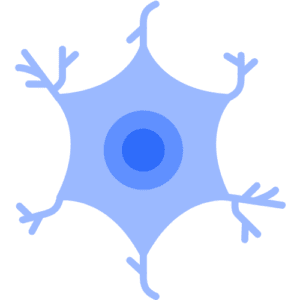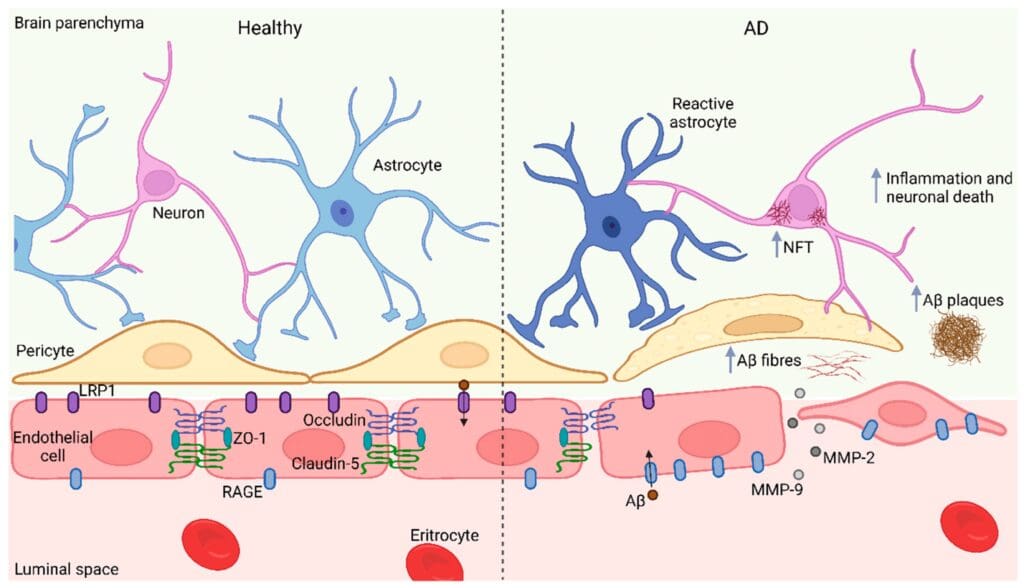The blood-brain barrier (BBB) is one of the body’s most crucial defense systems, acting as a gatekeeper that shields the brain from harmful substances while allowing essential nutrients to pass through. How does the Blood-Brain Barrier work and why is it important for health and disease? In this article, we will explore the structure and function of the BBB, examine its permeability, and discuss the challenges researchers face when studying it.
In recent years, advancements in microfluidics and the rise of 3D cell culture have transformed BBB research. Innovative tools have emerged, like BBB-on-a-chip, providing researchers with deeper insights into the BBB behavior and vulnerabilities.
What is the blood-brain barrier?
The blood brain barrier (BBB) is a natural protective layer of cells and capillaries creating a selective permeable barrier between the interstitium of the brain and the bloodstream. It regulates the movement of molecules between the blood and the brain, carefully selecting certain molecules to reach one side or the other. The BBB thus protects the brain from toxic compounds present in the bloodstream, and inversely also filters harmful molecules from the brain which could reach the bloodstream. Additionally, this protective barrier ensures a proper supply of nutrients to the brain by allowing molecules like oxygen or glucose to cross and reach the brain tissues.
[Figure 1] Schematic drawing of the Blood-brain Barrier.
Source: Blood-Brain Barrier Definition BioNinja. [Made by author on BioRender]
Breaking down the BBB Structure
Discovered at the beginning of the 20th century by experiments led by Paul Ehrlich and then Edwin Goldman, the biological components of the BBB have been identified over the last century. The BBB is composed of several cell types and junctional complexes ensuring permeability and maintaining a stable environment.

Endothelial cells (ECs) which are lining the cerebral blood vessels. They display a different phenotype from peripheral endothelial cells both in morphology and function. They have a flattened shape and are connected to each other by tight and adherens junctions.
These junctions seal the spaces between cells, hindering the flux of molecules through this layer. Tight junctions are thus a key element for the permeability property of the BBB. Among the differences with peripheral endothelial cells, cerebral ECs present no fenestration, i.e. small pores involved in filtration, which limits the exchange of molecules between the blood and the brain. Additionally, the increased amount of mitochondria found in those cells, comes with an increased need of energy for transport of substances.

Pericytes which are surrounding the endothelial cells, sharing a basement membrane and closely communicating with them. Both types of cells communicate through secreted signaling factors. The pericytes notably have an impact on the number of tight junctions and the polarization of the astrocytes.
They display an important phagocytic activity helping in the clearing of toxic compounds. The pericytes are thus involved in the maintenance and modulation of the BBB, while also modulating processes like the cerebral blood flow, neuroinflammation or the vascular development.

Astrocytes, star-shaped glial cells whose cell extensions named end-feet are surrounding the endothelial cells and blood vessels. They facilitate the migration of developing neurons and serve as buffers for potassium ions (K+) and neurotransmitters.
They contribute to the central nervous system (CNS) regulation through dynamic signaling for waste mangement, blood flow modulation, neuroimmune regulation and other processes. Their exact role in BBB, though, is still being investigated.

The Tight Junctions (TJs) are multi-protein complexes connecting adjacent cells and sealing the intercellular space, preventing leakage of solutes, ions and water. Those found in the BBB are 50-100 times closer than those found in peripheral capillaries, contributing to restricted transport of molecules.

The Basement Membrane (BM) composed of extracellular matrix between all the cell types described above, ensures structural support and also contributes to the barrier function of the BBB

[Figure 2] Schematic diagram of transverse section in blood-brain barrier illustrating its cellular structures.
Source: Alahmari A. Blood-Brain Barrier Overview: Structural and Functional Correlation. Neural Plasticity. 2021;2021:6564585. Published 2021 Dec 6. doi:10.1155/2021/6564585 [Made by author on BioRender]
The interactions of these different cell types together with efficient junctions and the multilayer structure ensure protection of the brain from harmful substances.
How does the blood-brain barrier function?
Several transport processes are present within the BBB to control the transmission of several types of molecules through the barrier.
- Small water-soluble molecules can pass via the paracellular area [Figure 3 – (A)], located between two neighboring ECs. This process is impacted by modifications in TJs, found in this specific area.
- Transcellular passive transport, across the endothelial cell is the process involved in the transport of lipid-soluble molecules [Figure 3 – (B)], including oxygen and carbon dioxide, for instance. This type of transport does not include all types of molecules and questions of size and polarity are also important. The passage of these molecules occurs via the transitory formation of pores, of finite size. Hence, larger molecules will be blocked. Other important parameters are the polar surface area and the number of hydrogen (H) bonds of the molecules. When a molecule display more than 8 H-bonds, the likelihood of it crossing the endothelial layer through passive diffusion is greatly reduced.
- Other essential nutrients like glucose or amino-acids can pass through the BBB via a carrier-mediated transport process [Figure 3 – (C)]. These molecules are carried across the barrier thanks to transporter proteins present in the cerebral capillaries. Drugs can also use these transporters to reach the brain, provided that they have the correct structural binding characteristics to match the transporter.
- The presence of cell surface receptors allows another process called receptor-mediated transcytosis (RMT), notably used for the transport of large molecular weight molecules [Figure 3 – (D)]. In this process, the molecule binds to the receptor, and together form a complex which triggers its endocytosis into the EC. This cluster is then exocytosed at the opposite side of the cell to reach the brain where the molecule dissociate from the receptor. RMT is a significantly used process to deliver drugs to the brain.
- The transport of macromolecules can also occur via adsorptive-mediated transcytosis (AMT) [Figure 3 – (E)] which is based on the electrostatic interactions resulting from the interaction between negatively-charged domains on the cellular membrane and positively-charged transporters.
Other natural transport processes observed in the BBB are evaluated as strategies to deliver drugs to the brain. They take advantage of permeability of the BBB to some cells like leukocytes or immune cells to bring drugs closer to the brain [Figure 3 – (F)]. The use of nanocarriers to deliver drugs across the BBB is also being studied, but still requires close analysis and examination to ensure the maintenance of the integrity of the BBB and the brain.

[Figure 3] Schematic diagram of endothelial cells that form the Blood-Brain Barrier and their associations with the perivascular end feet of astrocytes showing pathways across the BBB.
Source: Alahmari A. Blood-Brain Barrier Overview: Structural and Functional Correlation. Neural Plasticity. 2021;2021:6564585. Published 2021 Dec 6. doi:10.1155/2021/6564585
[Made by author on BioRender; Based on information in:
Chen Y., Liu L. Modern methods for delivery of drugs across the blood-brain barrier. Advanced Drug Delivery Reviews. 2012;64(7):640–665. doi:10.1016/j.addr.2011.11.010]
BBB Permeability: What gets through and what's blocked?
The following list is not exhaustive, but summarizes the main families of molecules which can cross or not the BBB.
| ✅ | ❌ |
|---|---|
| CO₂ | Toxins |
| Water | Proteins |
| Oxygen | Antibodies |
| Glucose | Large, polar molecules |
| Small, lipid-soluble molucules | Hydrophilic molecules |
| Some hormones | Dopamine |
| THC | Serotonine |
| Nicotine | Certain antibiotics |
| Some infections | Most infections |
| Some neuro drugs | Most drugs |
| Alcohol |
Logically and luckily, nutrients, essential for the brain function, can easily cross the BBB to ensure proper supply of oxygen, water or glucose.
Alterations of the BBB – What you need to know?
Because of its vital barrier function, maintaining the integrity and structure of the BBB is key. Unfortunately, in some conditions and diseases these parameters are impacted.
Environmental Factors
The BBB is sensitive to environmental factors which can impact its structure and function. Among those factors is an elevated body temperature, called hyperthermia, which has been observed to be linked with an alteration of the permeability of the BBB. A decrease in oxygen supply, resulting in hypoxia is also strongly connected with breakdown of the BBB, resulting in increased oxidative stress and permeability. As mentioned before, the crossing of some psychoactive molecules, like nicotine or alcohol, negatively impact the BBB and can lead to neurotoxicity.
Natural Degeneration
The functional components of the BBB can undergo alterations and degradation naturally as part of the aging process. This can be even accentuated by the presence of inflammation. The alteration of the BBB is often marked by a degradation or shrinkage of ECs, alteration of the tight junction proteins connecting cells and modified transport mechanisms which all together impact greatly the BBB permeability.
Neurodegenerative Disorders
These natural processes can be further enhanced in neurodegenerative disorders, like Alzheimer’s Disease (AD), Parkinson Disease (PD), Multiple Sclerosis (MS), Amyotrophic Lateral Sclerosis (ALS) or Huntington’s disease (HD), where breakdown of the BBB has been observed. Beyond the observation, remains the identifications of the causes of these degradation processes, which mostly remain unknown. It is thus, difficult to know whether the alteration of the BBB is a cause or a consequence or both of the related neurological pathology.

Alzheimer's disease effects on the blood-brain barrier: increased permeability, amyloid-beta buildup, inflammation, tau aggregation, and neuronal death.
Source:López-Ornelas A, Jiménez A, Pérez-Sánchez G, et al. The Impairment of Blood-Brain Barrier in Alzheimer's Disease: Challenges and Opportunities with Stem Cells. International Journal of Molecular Sciences. 2022;23(17):10136. Published 2022 Sep 4. doi:10.3390/ijms231710136
[Made by author on BioRender]
These pathologies, on top of being associated with a degradation of how the Blood-Brain Barrier work, all involve altered processes in the brain implied in the development of the disease. The BBB here thus play an even more important role as it is necessary to find treatment options that can cross the BBB and reach the brain.
Using Microfluidics to Model the Blood-Brain Barrier
The complex structure, location and interactions of the BBB makes it difficult to study. The development of 3D culture models and organ-on-chip platforms brought a degree of complexity to classic in vitro for more physiological models of organs including the BBB.
References
- Wu, D., Chen, Q., Chen, X. et al. The blood–brain barrier: Structure, regulation and drug delivery. Signal Transduction and Target Therapy. 2023;8(1):217. Published 2023 May 25. doi:10.1038/s41392-023-01481-w
- Neumaier F, Zlatopolskiy BD, Neumaier B. Drug Penetration into the Central Nervous System: Pharmacokinetic Concepts and In Vitro Model Systems. Pharmaceutics. 2021 Sep 23;13(10):1542. doi: 10.3390/pharmaceutics13101542
- Alahmari A. Blood-Brain Barrier Overview: Structural and Functional Correlation. Neural Plasticity. 2021;2021:6564585. Published 2021 Dec 6. doi:10.1155/2021/6564585
- Pimentel E, Sivalingam K, Doke M, Samikkannu T. Effects of Drugs of Abuse on the Blood-Brain Barrier: A Brief Overview. Frontiers in Neuroscience. 2020 May 21;14:513. doi: 10.3389/fnins.2020.00513
- Evans T. How Pathogens Penetrate the Blood-Brain Barrier. American Society for Microbiology. 2020.
- Zhao P, Zhang N, An Z. Engineering antibody and protein therapeutics to cross the blood-brain barrier. Antibody Therapeutics. 2022 Nov 9;5(4):311-331. doi: 10.1093/abt/tbac028
- Knox EG, Aburto MR, Clarke G, Cryan JF, O’Driscoll CM. The blood-brain barrier in aging and neurodegeneration. Molecular Psychiatry. 2022;27(6):2659-2673. doi:10.1038/s41380-022-01511-z
- López-Ornelas A, Jiménez A, Pérez-Sánchez G, et al. The Impairment of Blood-Brain Barrier in Alzheimer’s Disease: Challenges and Opportunities with Stem Cells. Int. Journal of Molecular Sciences. 2022;23(17):10136. Published 2022 Sep 4. doi:10.3390/ijms231710136
- Segarra M, Aburto MR, Acker-Palmer A. Blood-Brain Barrier Dynamics to Maintain Brain Homeostasis. Trends in Neurosciences. 2021;44(5):393-405. doi:10.1016/j.tins.2020.12.002


